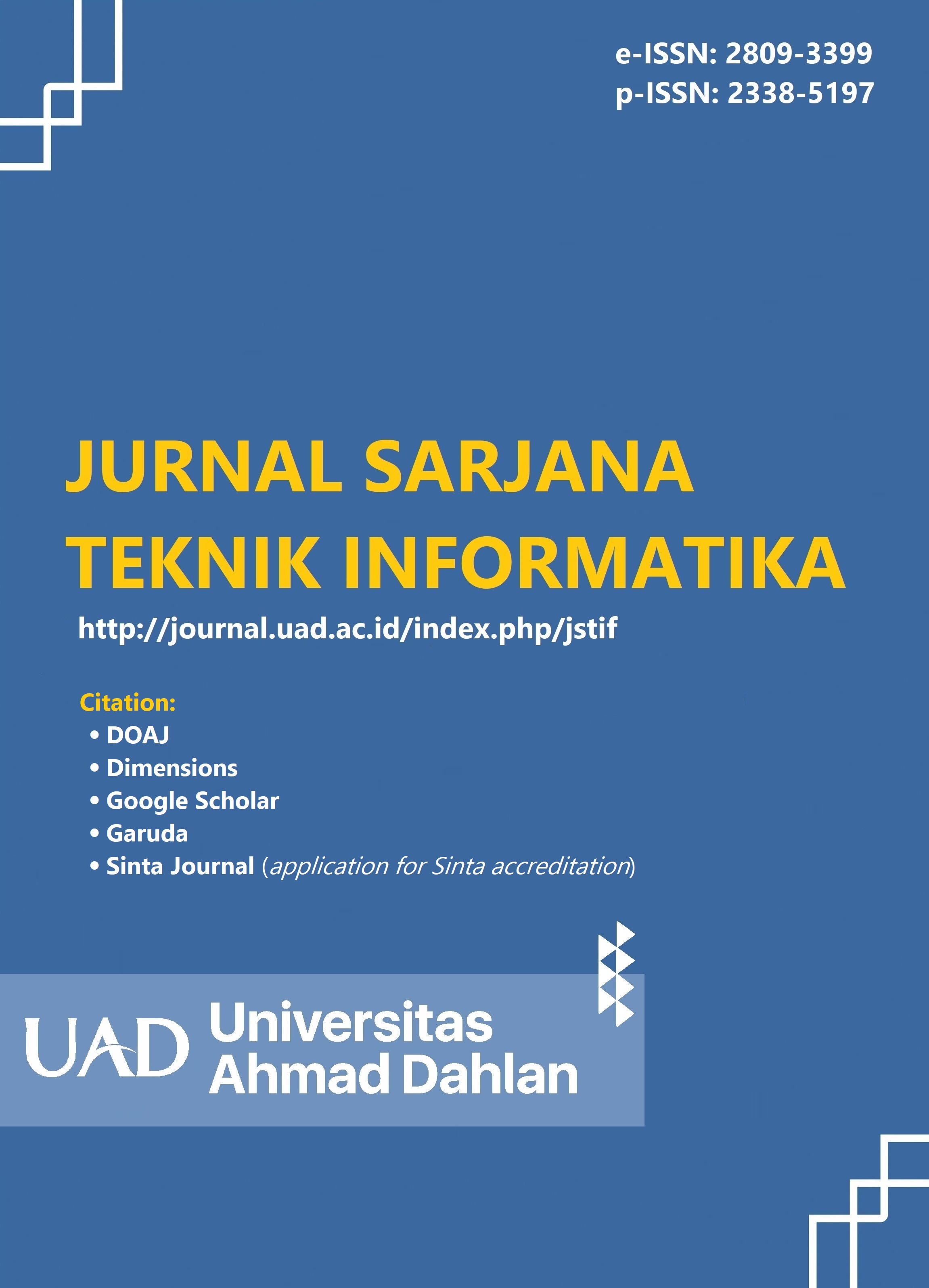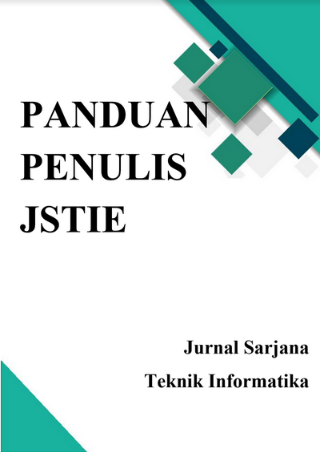Analisis Pengelompokan Penjualan Produk Silver Jewelry Pada CV. Borobudur Silver Menggunakan Metode Algoritma K-Means
DOI:
https://doi.org/10.12928/jstie.v12i2.28209Keywords:
Algoritma K-Means, Clustering, Data Mining, Metode Elbow, PenjualanAbstract
CV. Borobudur Silver adalah perusahaan di Yogyakarta yang bergerak di bergerak di bidang perdagangan perhiasan perak. Masalah yang masih terjadi pada toko adalah peningkatan permintaan suatu produk dari pelanggan tetapi toko tidak mampu memenuhi karena stok produk tidak tersedia. Hal tersebut terjadi karena kurang pemahaman terkait pola penjualan sehingga penyediaan stok produk tidak efisien. Oleh karena itu, dibutuhkan pengetahuan terkait pola penjualan dengan dilakukan pengelompokan data berdasarkan tingkat penjualan. Pengelompokan dapat dilakukan menggunakan metode clustering data mining dengan menerapkan algoritma k-means. Penelitian ini dimulai dengan tahap pembersihan data, penentuan nilai k dengan metode elbow, implementasi dengan algoritma k-means, dan pengujian dengan metode silhouette coefficient. Proses analisis menggunakan 526 data transaksi produk dari bulan Oktober sampai Desember tahun 2022. Pengelompokan Oktober, cluster tertinggi didominasi produk gelang kaki, cluster sedang didominasi produk anting, dan cluster rendah didominasi produk gelag tangan dengan hasil pengujian kualitas cluster sebesar 0,685. Pengelompokan November, untuk cluster tertinggi didominasi cincin, cluster sedang didominasi produk kalung, dan cluster rendah didominasi produk anting dengan hasil pengujian kualitas cluster sebesar 0,898. Pengelompokan Desember, cluster tertinggi didominasi produk bros plated, cluster sedang didominasi produk gelang tangan, dan cluster rendah didominasi produk anting dengan hasil pengujian kualitas cluster sebesar 0,823.
References
F. Redjeki, H. Fauzi, and S. Priadana, “Implementation of Appropriate Marketing and Sales Strategies in Improving Company Performance and Profits,” Int. J. Sci. Soc., vol. 3, no. 2, pp. 31–38, Apr. 2021, doi: 10.54783/ijsoc.v3i2.314.
D. J. Teece, “Business Models, Business Strategy and Innovation,” Long Range Plann., vol. 43, no. 2–3, pp. 172–194, Apr. 2010, doi: 10.1016/j.lrp.2009.07.003.
H. Siagian, Z. J. H. Tarigan, and F. Jie, “Supply Chain Integration Enables Resilience, Flexibility, and Innovation to Improve Business Performance in COVID-19 Era,” Sustainability, vol. 13, no. 9, p. 4669, Apr. 2021, doi: 10.3390/su13094669.
N. Normah, S. Nurajizah, and A. Salbinda, “Penerapan Data Mining Metode Kmeans Clustering untuk Analisa Penjualan pada Toko Fashion Hijab Banten,” J. Tek. Komput. AMIK BSI, vol. 7, no. 2, pp. 158–163, 2021, doi: https://doi.org/10.31294/jtk.v4i2.
M. H. Santoso, “Application of Association Rule Method Using Apriori Algorithm to Find Sales Patterns Case Study of Indomaret Tanjung Anom,” Brill. Res. Artif. Intell., vol. 1, no. 2, pp. 54–66, Dec. 2021, doi: 10.47709/brilliance.v1i2.1228.
M. Ahmed, R. Seraj, and S. M. S. Islam, “The k-means Algorithm: A Comprehensive Survey and Performance Evaluation,” Electronics, vol. 9, no. 8, p. 1295, Aug. 2020, doi: 10.3390/electronics9081295.
I. Safira, R. Salkiawati, and W. Priatna, “Penerapan Algoritma K-Means untuk Mengetahui Pola Persediaan Barang pada Toko Raja Bekasi,” J. Inform. Inf. Secur., vol. 3, no. 1, pp. 99–110, Jul. 2022, doi: 10.31599/jiforty.v3i1.1253.
A. P. Pramudiansyah, “Segmentasi Pelanggan Menggunakan Algoritma K-Means Berdasarkan Model Recency Frequency Monetary,” J. Ilm. Ilmu Komput., vol. 7, no. 2, pp. 06–19, 2021, doi: 10.35329/jiik.v7i2.201.
R. K. Dinata, S. Safwandi, N. Hasdyna, and N. Azizah, “Analisis K-Means Clustering pada Data Sepeda Motor,” INFORMAL Informatics J., vol. 5, no. 1, p. 10, 2020, doi: 10.19184/isj.v5i1.17071.
L. G. Rady Putra and A. Anggrawan, “Pengelompokan Penerima Bantuan Sosial Masyarakat dengan Metode K-Means,” MATRIK J. Manajemen, Tek. Inform. dan Rekayasa Komput., vol. 21, no. 1, pp. 205–214, Nov. 2021, doi: 10.30812/matrik.v21i1.1554.
Downloads
Published
Issue
Section
License
License and Copyright Agreement
In submitting the manuscript to the journal, the authors certify that:
- They are authorized by their co-authors to enter into these arrangements.
- The work described has not been formally published before, except in the form of an abstract or as part of a published lecture, review, thesis, or overlay journal. Please also carefully read Journal Posting Your Article Policy.
- The work is not under consideration for publication elsewhere.
- The work has been approved by all the author(s) and by the responsible authorities – tacitly or explicitly – of the institutes where the work has been carried out.
- They secure the right to reproduce any material that has already been published or copyrighted elsewhere.
- They agree to the following license and copyright agreement.
Copyright
Authors who publish with Jurnal Sarjana Teknik Informatika agree to the following terms:
- Authors retain copyright and grant the journal right of first publication with the work simultaneously licensed under a Creative Commons Attribution License (CC BY-SA 4.0) that allows others to share the work with an acknowledgement of the work's authorship and initial publication in this journal.
- Authors are able to enter into separate, additional contractual arrangements for the non-exclusive distribution of the journal's published version of the work (e.g., post it to an institutional repository or publish it in a book), with an acknowledgement of its initial publication in this journal.
- Authors are permitted and encouraged to post their work online (e.g., in institutional repositories or on their website) prior to and during the submission process, as it can lead to productive exchanges, as well as earlier and greater citation of published work.








